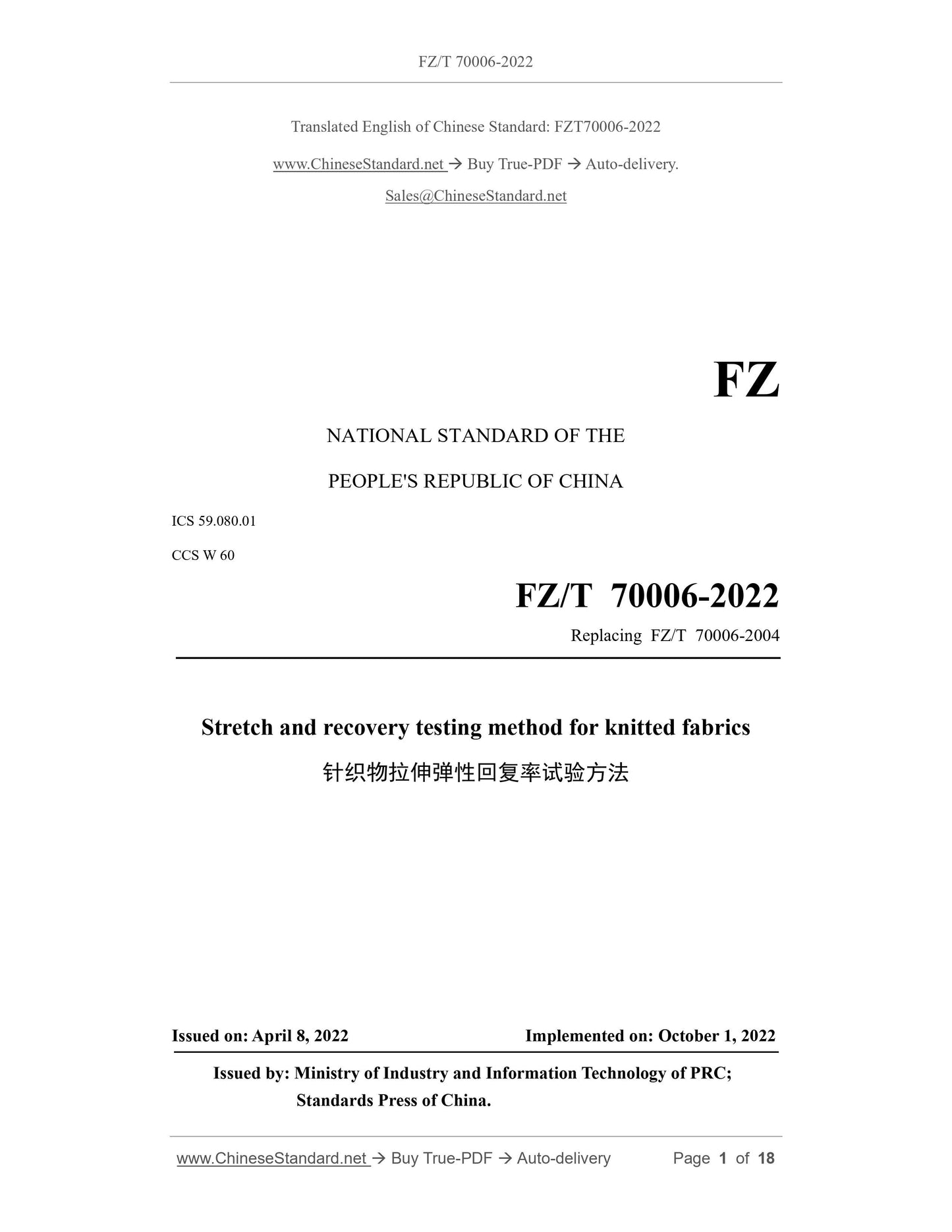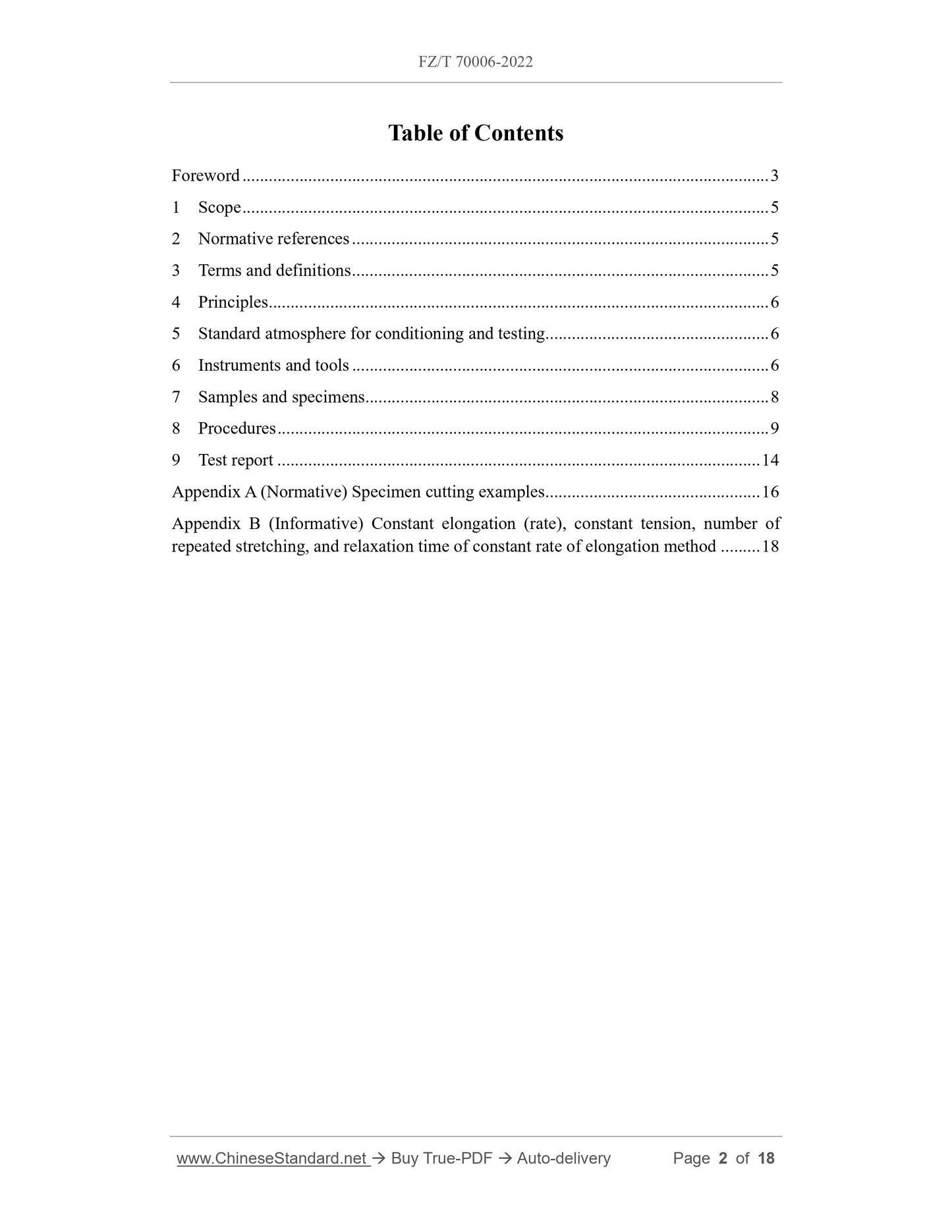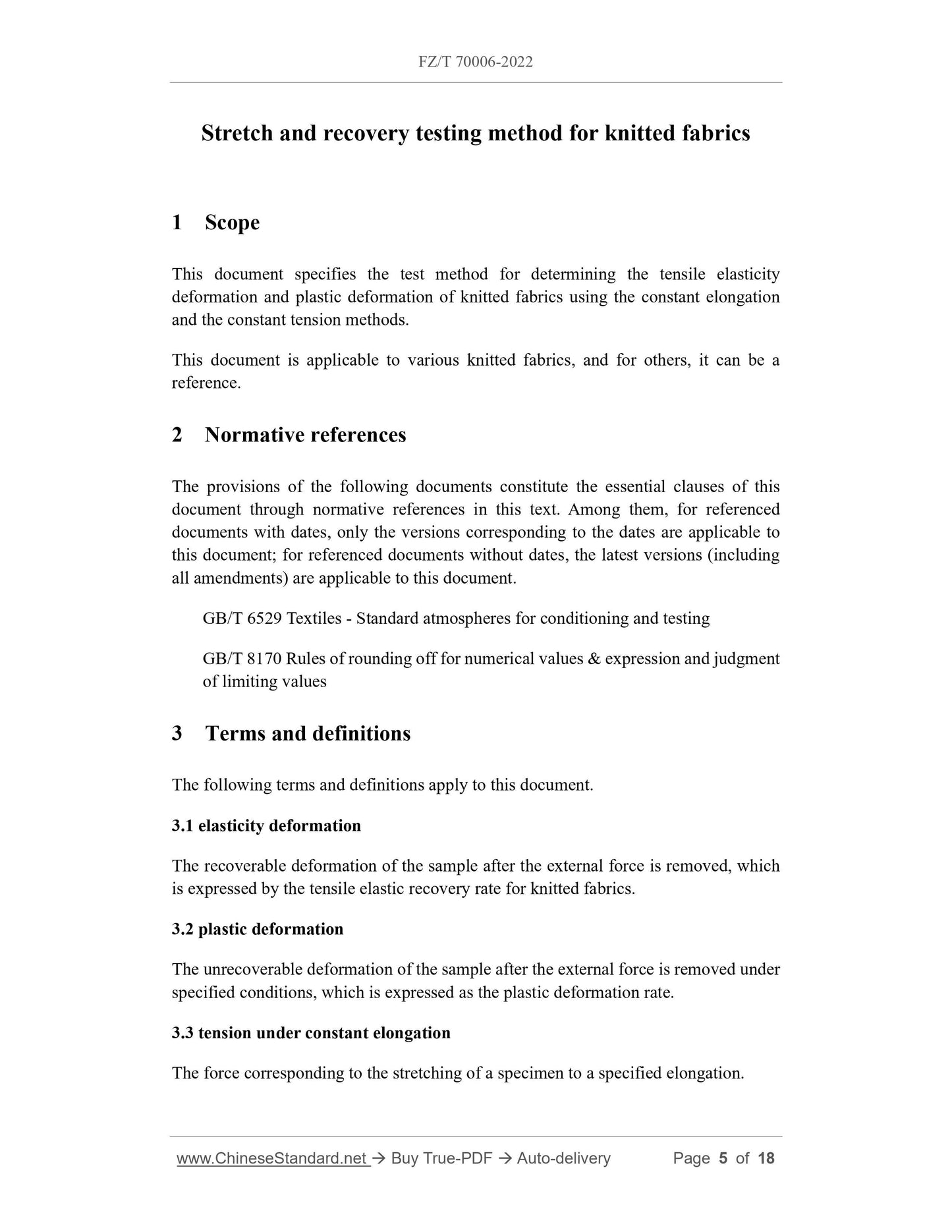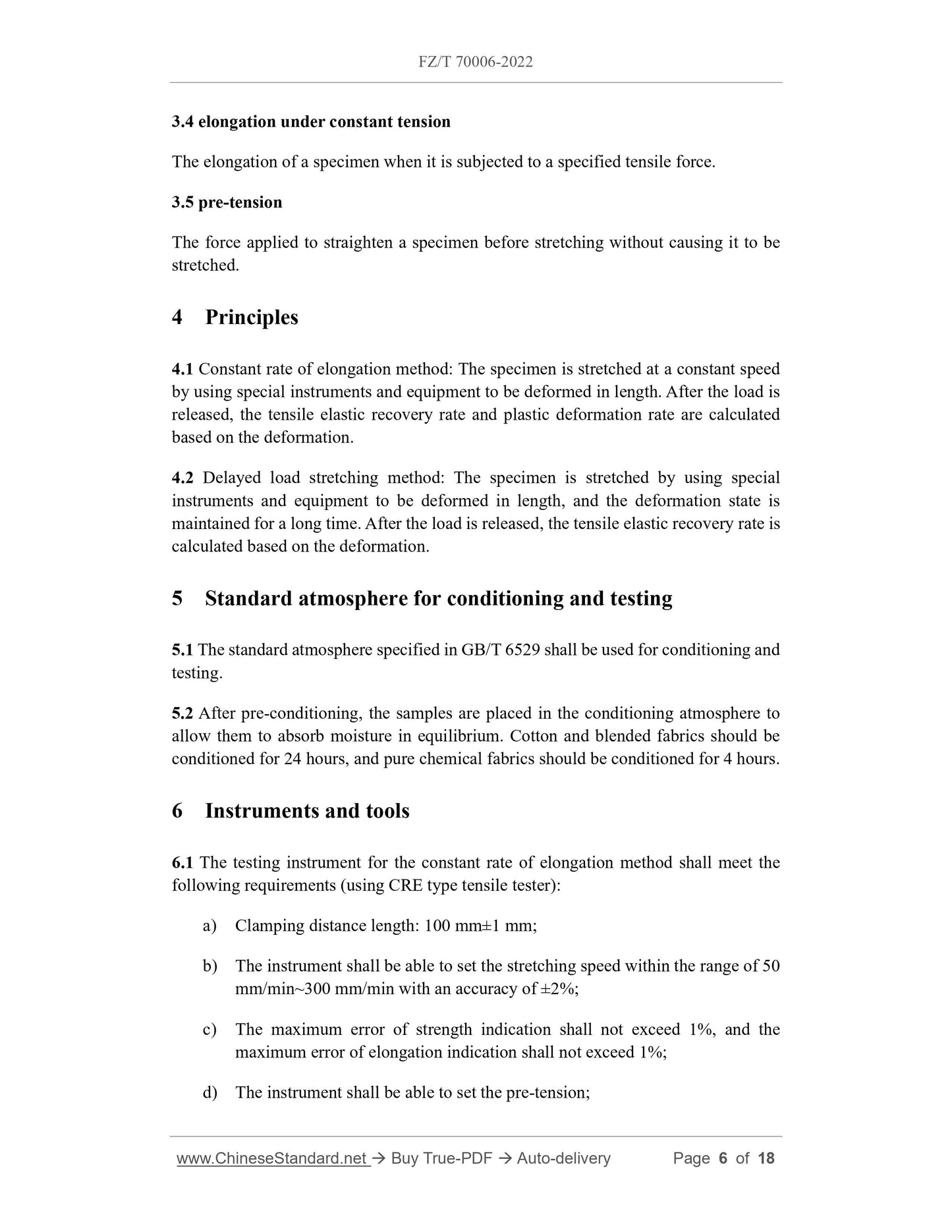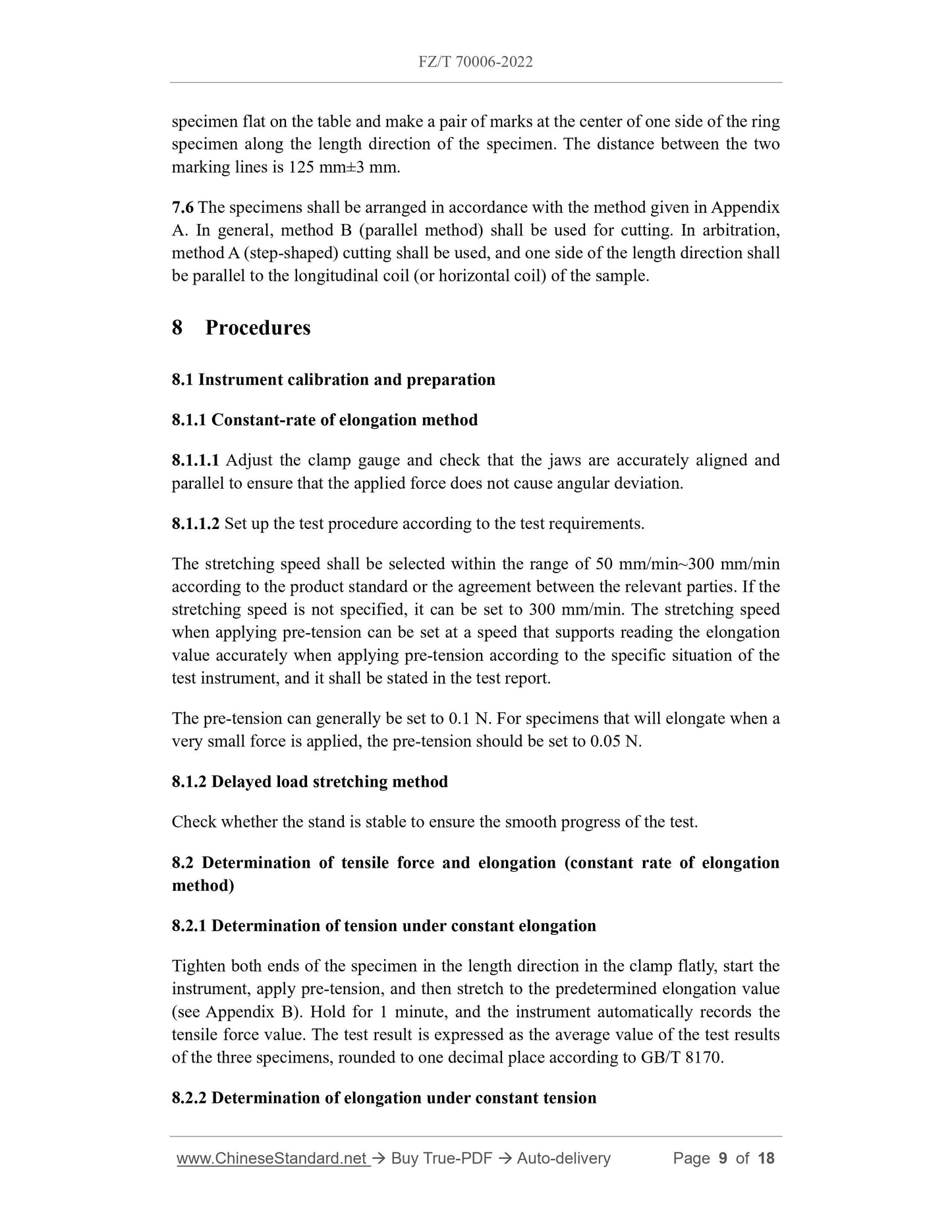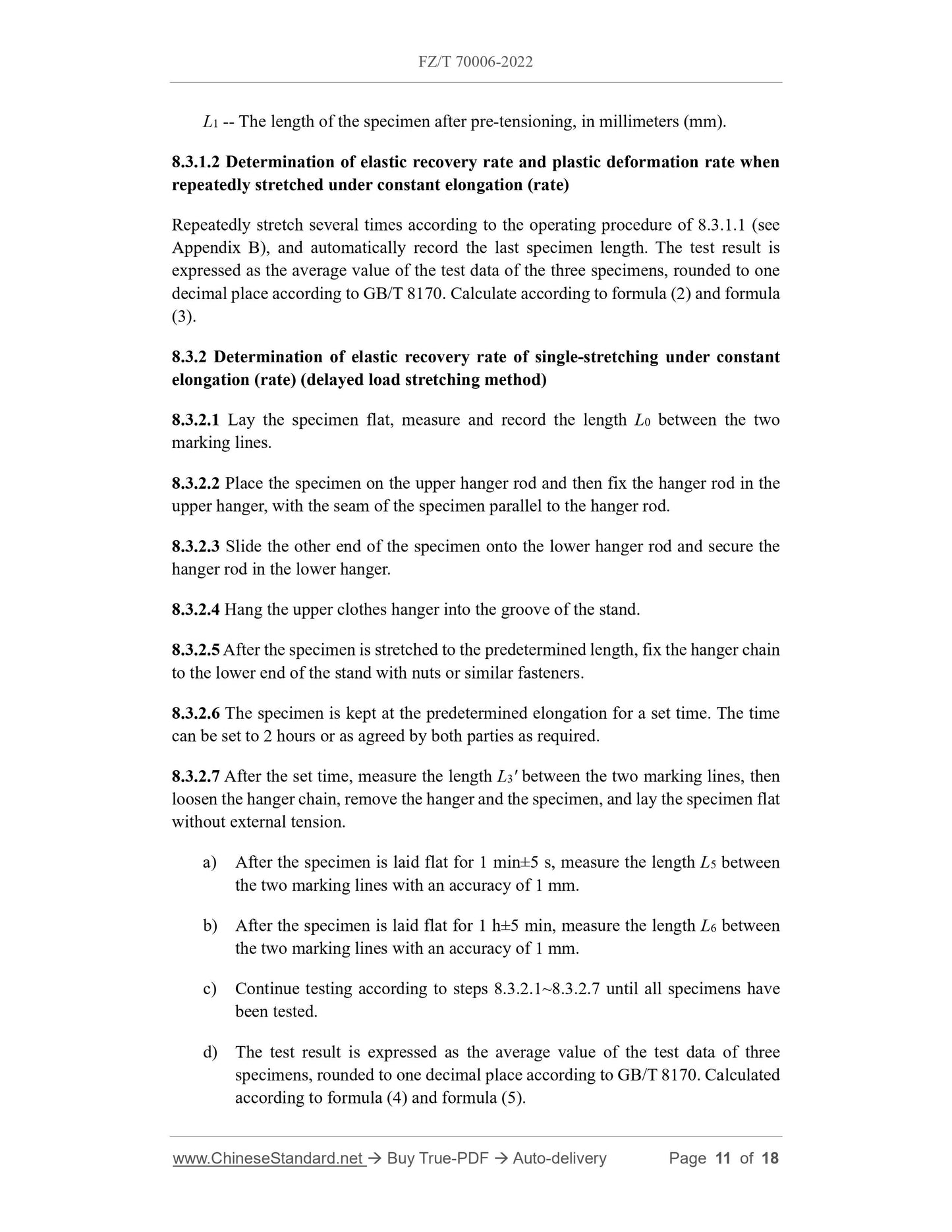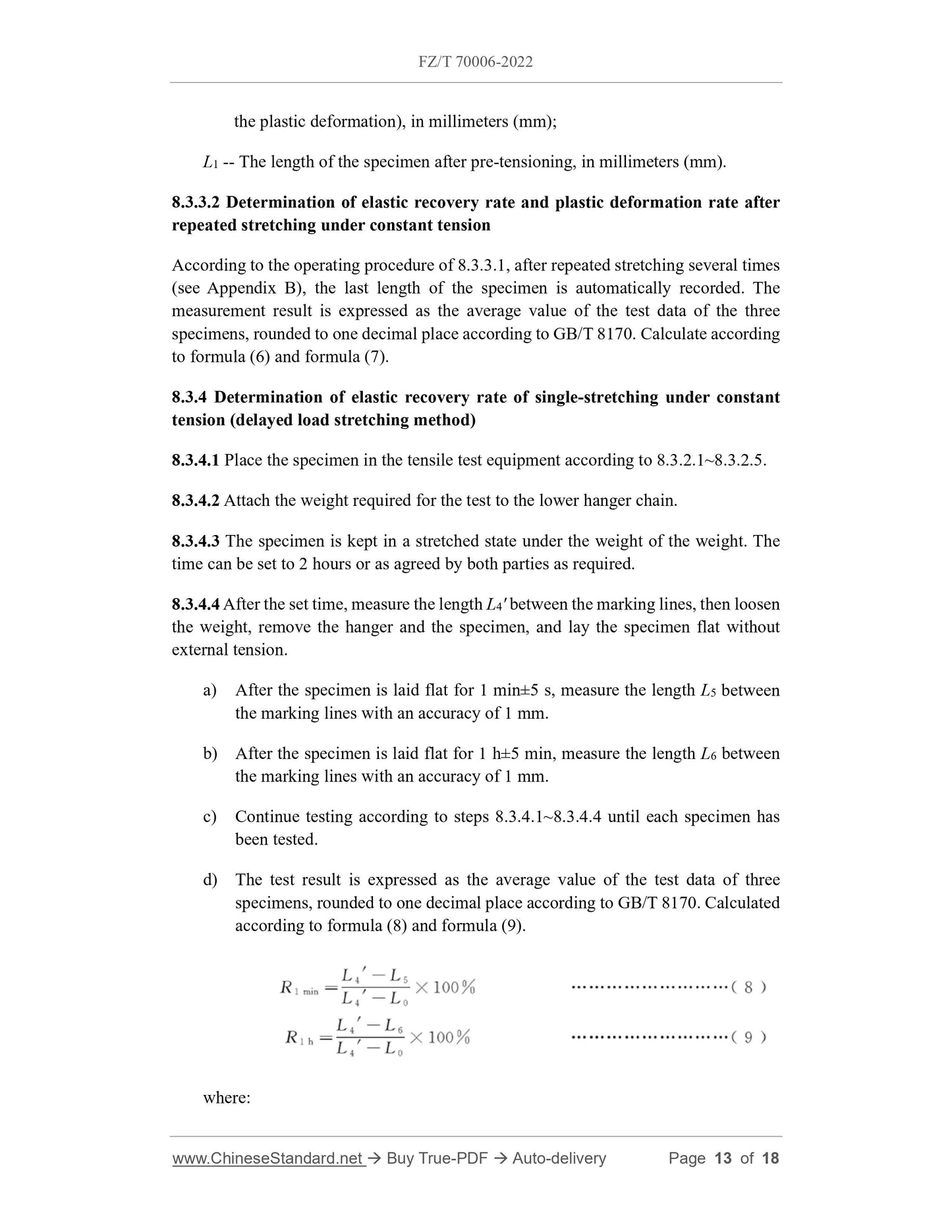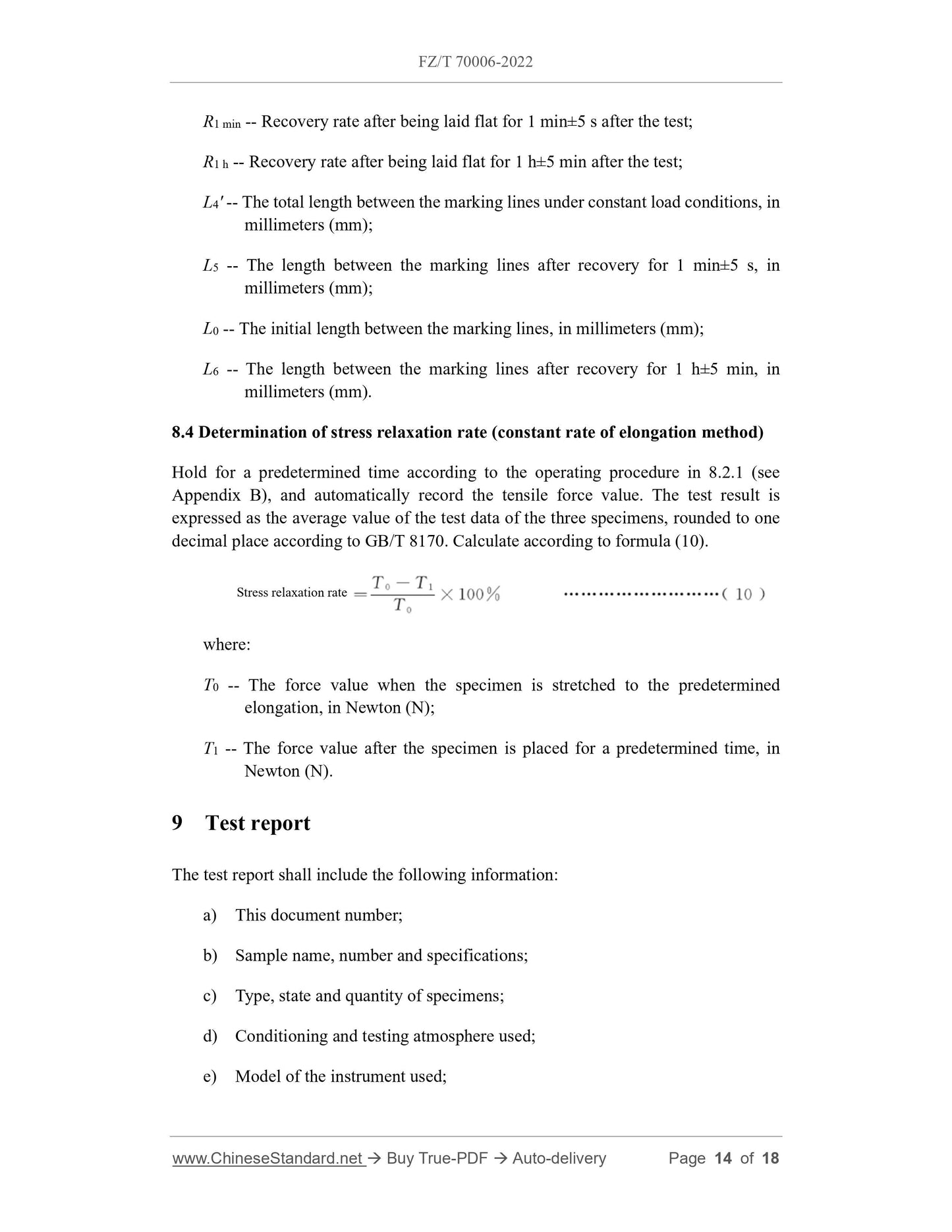PayPal, credit cards. Download editable-PDF and invoice in 1 second!
FZ/T 70006-2022 English PDF (FZT70006-2022)
FZ/T 70006-2022 English PDF (FZT70006-2022)
Precio habitual
$245.00 USD
Precio habitual
Precio de oferta
$245.00 USD
Precio unitario
/
por
Los gastos de envío se calculan en la pantalla de pago.
No se pudo cargar la disponibilidad de retiro
Delivery: 3 seconds. Download true-PDF + Invoice.
Get QUOTATION in 1-minute: Click FZ/T 70006-2022
Historical versions: FZ/T 70006-2022
Preview True-PDF (Reload/Scroll if blank)
FZ/T 70006-2022: Stretch and recovery testing method for knitted fabrics
FZ/T 70006-2022
FZ
NATIONAL STANDARD OF THE
PEOPLE'S REPUBLIC OF CHINA
ICS 59.080.01
CCS W 60
Replacing FZ/T 70006-2004
Stretch and recovery testing method for knitted fabrics
ISSUED ON: APRIL 8, 2022
IMPLEMENTED ON: OCTOBER 1, 2022
Issued by: Ministry of Industry and Information Technology of PRC;
Standards Press of China.
Table of Contents
Foreword ... 3
1 Scope ... 5
2 Normative references ... 5
3 Terms and definitions ... 5
4 Principles ... 6
5 Standard atmosphere for conditioning and testing ... 6
6 Instruments and tools ... 6
7 Samples and specimens ... 8
8 Procedures ... 9
9 Test report ... 14
Appendix A (Normative) Specimen cutting examples ... 16
Appendix B (Informative) Constant elongation (rate), constant tension, number of
repeated stretching, and relaxation time of constant rate of elongation method ... 18
Stretch and recovery testing method for knitted fabrics
1 Scope
This document specifies the test method for determining the tensile elasticity
deformation and plastic deformation of knitted fabrics using the constant elongation
and the constant tension methods.
This document is applicable to various knitted fabrics, and for others, it can be a
reference.
2 Normative references
The provisions of the following documents constitute the essential clauses of this
document through normative references in this text. Among them, for referenced
documents with dates, only the versions corresponding to the dates are applicable to
this document; for referenced documents without dates, the latest versions (including
all amendments) are applicable to this document.
GB/T 6529 Textiles - Standard atmospheres for conditioning and testing
GB/T 8170 Rules of rounding off for numerical values and expression and judgment
of limiting values
3 Terms and definitions
The following terms and definitions apply to this document.
3.1 elasticity deformation
The recoverable deformation of the sample after the external force is removed, which
is expressed by the tensile elastic recovery rate for knitted fabrics.
3.2 plastic deformation
The unrecoverable deformation of the sample after the external force is removed under
specified conditions, which is expressed as the plastic deformation rate.
3.3 tension under constant elongation
The force corresponding to the stretching of a specimen to a specified elongation.
3.4 elongation under constant tension
The elongation of a specimen when it is subjected to a specified tensile force.
3.5 pre-tension
The force applied to straighten a specimen before stretching without causing it to be
stretched.
4 Principles
4.1 Constant rate of elongation method: The specimen is stretched at a constant speed
by using special instruments and equipment to be deformed in length. After the load is
released, the tensile elastic recovery rate and plastic deformation rate are calculated
based on the deformation.
4.2 Delayed load stretching method: The specimen is stretched by using special
instruments and equipment to be deformed in length, and the deformation state is
maintained for a long time. After the load is released, the tensile elastic recovery rate is
calculated based on the deformation.
5 Standard atmosphere for conditioning and testing
5.1 The standard atmosphere specified in GB/T 6529 shall be used for conditioning and
testing.
5.2 After pre-conditioning, the samples are placed in the conditioning atmosphere to
allow them to absorb moisture in equilibrium. Cotton and blended fabrics should be
conditioned for 24 hours, and pure chemical fabrics should be conditioned for 4 hours.
6 Instruments and tools
6.1 The testing instrument for the constant rate of elongation method shall meet the
following requirements (using CRE type tensile tester):
a) Clamping distance length: 100 mm±1 mm;
b) The instrument shall be able to set the stretching speed within the range of 50
mm/min~300 mm/min with an accuracy of ±2%;
c) The maximum error of strength indication shall not exceed 1%, and the
maximum error of elongation indication shall not exceed 1%;
d) The instrument shall be able to set the pre-tension;
specimen flat on the table and make a pair of marks at the center of one side of the ring
specimen along the length direction of the specimen. The distance between the two
marking lines is 125 mm±3 mm.
7.6 The specimens shall be arranged in accordance with the method given in Appendix
A. In general, method B (parallel method) shall be used for cutting. In arbitration,
method A (step-shaped) cutting shall be used, and one side of the length direction shall
be parallel to the longitudinal coil (or horizontal coil) of the sample.
8 Procedures
8.1 Instrument calibration and preparation
8.1.1 Constant-rate of elongation method
8.1.1.1 Adjust the clamp gauge and check that the jaws are accurately aligned and
parallel to ensure that the applied force does not cause angular deviation.
8.1.1.2 Set up the test procedure according to the test requirements.
The stretching speed shall be selected within the range of 50 mm/min~300 mm/min
according to the product standard or the agreement between the relevant parties. If the
stretching speed is not specified, it can be set to 300 mm/min. The stretching speed
when applying pre-tension can be set at a speed that supports reading the elongation
value accurately when applying pre-tension according to the specific situation of the
test instrument, and it shall be stated in the test report.
The pre-tension can generally be set to 0.1 N. For specimens that will elongate when a
very small force is applied, the pre-tension should be set to 0.05 N.
8.1.2 Delayed load stretching method
Check whether the stand is stable to ensure the smooth progress of the test.
8.2 Determination of tensile force and elongation (constant rate of elongation
method)
8.2.1 Determination of tension under constant elongation
Tighten both ends of the specimen in the length direction in the clamp flatly, start the
instrument, apply pre-tension, and then stretch to the predetermined elongation value
(see Appendix B). Hold for 1 minute, and the instrument automatically records the
tensile force value. The test result is expressed as the average value of the test results
of the three specimens, rounded to one decimal place according to GB/T 8170.
8.2.2 Determination of elongation under constant tension
L1 -- The length of the specimen after pre-tensioning, in millimeters (mm).
8.3.1.2 Determination of elastic recovery rate and plastic deformation rate when
repeatedly stretched under constant elongation (rate)
Repeatedly stretch several times according to the operating procedure of 8.3.1.1 (see
Appendix B), and automatically record the last specimen length. The test result is
expressed as the average value of the test data of the three specimens, rounded to one
decimal place according to GB/T 8170. Calculate according to formula (2) and formula
(3).
8.3.2 Determination of elastic recovery rate of single-stretching under constant
elongation (rate) (delayed load stretching method)
8.3.2.1 Lay the specimen flat, measure and record the length L0 between the two
marking lines.
8.3.2.2 Place the specimen on the upper hanger rod and then fix the hanger rod in the
upper hanger, with the seam of the specimen parallel to the hanger rod.
8.3.2.3 Slide the other end of the specimen onto the lower hanger rod and secure the
hanger rod in th...
Get QUOTATION in 1-minute: Click FZ/T 70006-2022
Historical versions: FZ/T 70006-2022
Preview True-PDF (Reload/Scroll if blank)
FZ/T 70006-2022: Stretch and recovery testing method for knitted fabrics
FZ/T 70006-2022
FZ
NATIONAL STANDARD OF THE
PEOPLE'S REPUBLIC OF CHINA
ICS 59.080.01
CCS W 60
Replacing FZ/T 70006-2004
Stretch and recovery testing method for knitted fabrics
ISSUED ON: APRIL 8, 2022
IMPLEMENTED ON: OCTOBER 1, 2022
Issued by: Ministry of Industry and Information Technology of PRC;
Standards Press of China.
Table of Contents
Foreword ... 3
1 Scope ... 5
2 Normative references ... 5
3 Terms and definitions ... 5
4 Principles ... 6
5 Standard atmosphere for conditioning and testing ... 6
6 Instruments and tools ... 6
7 Samples and specimens ... 8
8 Procedures ... 9
9 Test report ... 14
Appendix A (Normative) Specimen cutting examples ... 16
Appendix B (Informative) Constant elongation (rate), constant tension, number of
repeated stretching, and relaxation time of constant rate of elongation method ... 18
Stretch and recovery testing method for knitted fabrics
1 Scope
This document specifies the test method for determining the tensile elasticity
deformation and plastic deformation of knitted fabrics using the constant elongation
and the constant tension methods.
This document is applicable to various knitted fabrics, and for others, it can be a
reference.
2 Normative references
The provisions of the following documents constitute the essential clauses of this
document through normative references in this text. Among them, for referenced
documents with dates, only the versions corresponding to the dates are applicable to
this document; for referenced documents without dates, the latest versions (including
all amendments) are applicable to this document.
GB/T 6529 Textiles - Standard atmospheres for conditioning and testing
GB/T 8170 Rules of rounding off for numerical values and expression and judgment
of limiting values
3 Terms and definitions
The following terms and definitions apply to this document.
3.1 elasticity deformation
The recoverable deformation of the sample after the external force is removed, which
is expressed by the tensile elastic recovery rate for knitted fabrics.
3.2 plastic deformation
The unrecoverable deformation of the sample after the external force is removed under
specified conditions, which is expressed as the plastic deformation rate.
3.3 tension under constant elongation
The force corresponding to the stretching of a specimen to a specified elongation.
3.4 elongation under constant tension
The elongation of a specimen when it is subjected to a specified tensile force.
3.5 pre-tension
The force applied to straighten a specimen before stretching without causing it to be
stretched.
4 Principles
4.1 Constant rate of elongation method: The specimen is stretched at a constant speed
by using special instruments and equipment to be deformed in length. After the load is
released, the tensile elastic recovery rate and plastic deformation rate are calculated
based on the deformation.
4.2 Delayed load stretching method: The specimen is stretched by using special
instruments and equipment to be deformed in length, and the deformation state is
maintained for a long time. After the load is released, the tensile elastic recovery rate is
calculated based on the deformation.
5 Standard atmosphere for conditioning and testing
5.1 The standard atmosphere specified in GB/T 6529 shall be used for conditioning and
testing.
5.2 After pre-conditioning, the samples are placed in the conditioning atmosphere to
allow them to absorb moisture in equilibrium. Cotton and blended fabrics should be
conditioned for 24 hours, and pure chemical fabrics should be conditioned for 4 hours.
6 Instruments and tools
6.1 The testing instrument for the constant rate of elongation method shall meet the
following requirements (using CRE type tensile tester):
a) Clamping distance length: 100 mm±1 mm;
b) The instrument shall be able to set the stretching speed within the range of 50
mm/min~300 mm/min with an accuracy of ±2%;
c) The maximum error of strength indication shall not exceed 1%, and the
maximum error of elongation indication shall not exceed 1%;
d) The instrument shall be able to set the pre-tension;
specimen flat on the table and make a pair of marks at the center of one side of the ring
specimen along the length direction of the specimen. The distance between the two
marking lines is 125 mm±3 mm.
7.6 The specimens shall be arranged in accordance with the method given in Appendix
A. In general, method B (parallel method) shall be used for cutting. In arbitration,
method A (step-shaped) cutting shall be used, and one side of the length direction shall
be parallel to the longitudinal coil (or horizontal coil) of the sample.
8 Procedures
8.1 Instrument calibration and preparation
8.1.1 Constant-rate of elongation method
8.1.1.1 Adjust the clamp gauge and check that the jaws are accurately aligned and
parallel to ensure that the applied force does not cause angular deviation.
8.1.1.2 Set up the test procedure according to the test requirements.
The stretching speed shall be selected within the range of 50 mm/min~300 mm/min
according to the product standard or the agreement between the relevant parties. If the
stretching speed is not specified, it can be set to 300 mm/min. The stretching speed
when applying pre-tension can be set at a speed that supports reading the elongation
value accurately when applying pre-tension according to the specific situation of the
test instrument, and it shall be stated in the test report.
The pre-tension can generally be set to 0.1 N. For specimens that will elongate when a
very small force is applied, the pre-tension should be set to 0.05 N.
8.1.2 Delayed load stretching method
Check whether the stand is stable to ensure the smooth progress of the test.
8.2 Determination of tensile force and elongation (constant rate of elongation
method)
8.2.1 Determination of tension under constant elongation
Tighten both ends of the specimen in the length direction in the clamp flatly, start the
instrument, apply pre-tension, and then stretch to the predetermined elongation value
(see Appendix B). Hold for 1 minute, and the instrument automatically records the
tensile force value. The test result is expressed as the average value of the test results
of the three specimens, rounded to one decimal place according to GB/T 8170.
8.2.2 Determination of elongation under constant tension
L1 -- The length of the specimen after pre-tensioning, in millimeters (mm).
8.3.1.2 Determination of elastic recovery rate and plastic deformation rate when
repeatedly stretched under constant elongation (rate)
Repeatedly stretch several times according to the operating procedure of 8.3.1.1 (see
Appendix B), and automatically record the last specimen length. The test result is
expressed as the average value of the test data of the three specimens, rounded to one
decimal place according to GB/T 8170. Calculate according to formula (2) and formula
(3).
8.3.2 Determination of elastic recovery rate of single-stretching under constant
elongation (rate) (delayed load stretching method)
8.3.2.1 Lay the specimen flat, measure and record the length L0 between the two
marking lines.
8.3.2.2 Place the specimen on the upper hanger rod and then fix the hanger rod in the
upper hanger, with the seam of the specimen parallel to the hanger rod.
8.3.2.3 Slide the other end of the specimen onto the lower hanger rod and secure the
hanger rod in th...
Share
